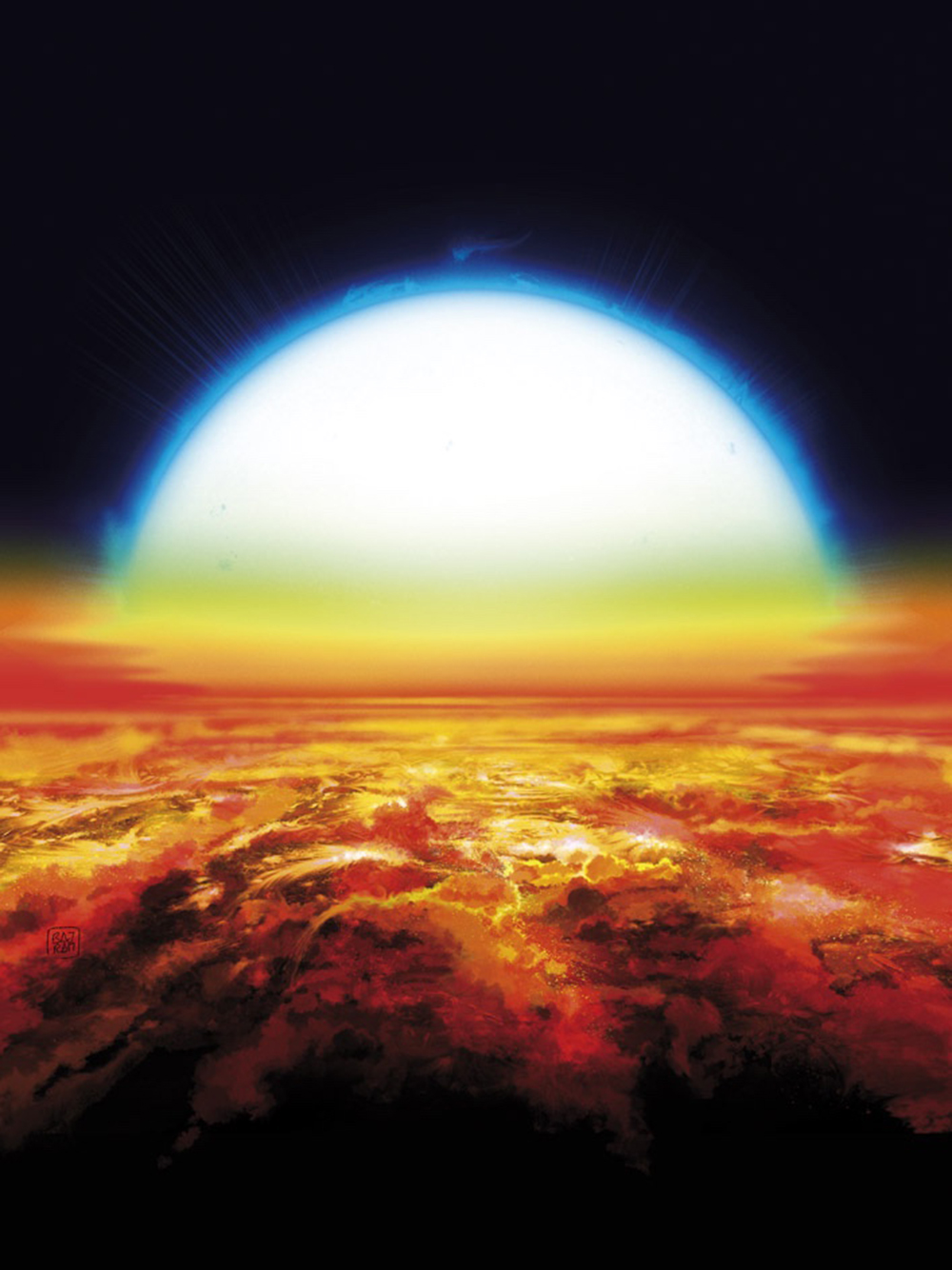Iron and titanium discovered in the atmosphere of an exoplanet
For the first time, researchers of the universities of Bern and Geneva have proven the presence of iron and titanium in the atmosphere of an exoplanet. The existence of these elements in gas form was theoretically predicted by a team led by the Bernese astronomer Kevin Heng and has now been confirmed by Geneva-based astronomers.
Planets in other solar systems, so-called exoplanets, can revolve very closely around their star. If this star is much hotter than our sun, a unique phenomenon occurs: the exoplanet itself becomes as hot as a star. Because such gas giants are physically similar to Jupiter, they are also called "hot Jupiters" or "ultra-hot Jupiters".
KELT-9 is a star located 650 light years from the earth in the Cygnus constellation. With a temperature of over 10,000 °C, it is nearly twice as hot as the sun. KELT-9 is orbited by a huge gas planet, the "ultra-hot Jupiter" KELT-9b, which is 30 times closer to its central star than the earth is to the sun. Due to this proximity, the exoplanet orbits its star in 36 hours and it is heated to a temperature of over 4,000 °C. Thus, although the planet KELT-9b is not as hot as the sun, it is hotter than many other stars.
What the atmosphere of such a "hot Jupiter" could look like and how it developed under such conditions was previously unknown. Now, a team under the direction of the University of Geneva that has merged with scientists of the University of Bern has proved the existence of iron and titanium atoms in the atmosphere of the "ultra-hot Jupiter" KELT-9b, thanks to a simulation of the Bernese researcher group. The discovery was published in the journal Nature.
Simulation of Bernese team the trigger
Researchers of the University of Bern who are part of the National Centre of Competence in Research PlanetS recently conducted a study in order to simulate the atmosphere of the exoplanet KELT-9b. The results are being published in the Astrophysical Journal.
"The results of these simulations showed that most of the molecules in the atmosphere of KELT-9b should be in atom form", explains the co-author of the study Kevin Heng, Director and Professor at the Center for Space and Habitabilty (CSH) at the University of Bern and a member of PlanetS. "With the extremely high temperatures on KELT-9b, collisions take place between the particles that break up the compounds between the molecules and even partially ionise the atoms that arise here," continues lead author Daniel Kitzmann from the CSH. The simulations of the Bernese team also predicted that it should be possible to observe gaseous atomic iron in the atmosphere of the planet KELT-9b with the aid of telescopes.
Light reveals the chemical components of the atmosphere
Researchers of PlanetS at the University of Geneva observed the planet KELT-9b during a transit in front of its central star, KELT-9. A tiny fraction of the light of the star KELT-9 is filtered through the atmosphere of the planet KELT-9b during this transit. If this filtered light is now analysed, conclusions can be drawn from it about the chemical composition of the atmosphere of the planet KELT-9b. This is possible thanks to a spectrograph that divides the white light into its components, the so-called spectrum. For their observations, the Geneva researchers used the HARPS North Spectrograph in La Palma, which had been built in Geneva.
As predicted by Heng’s team, iron atoms, if present in the atmosphere of KELT-9b, leave behind a well recognisable "fingerprint" in the spectrum. The Geneva researchers of PlanetS discovered a strong signal that corresponds to that of iron vapour. "With the theoretical predictions of Heng’s team, we only needed to follow a sort of treasure map," says Jens Hoeijmakers, a researcher at the Universities of Bern and Geneva and lead author of the study in Nature. "When we occupied ourselves more intensively with the data, we found even more," he adds. In addition to the atoms, the researchers also proved the existence of both iron and titanium in ionised form in the atmosphere of KELT-9b.
Previously, it was assumed that many exoplanets that found themselves in a similar environment to KELT-9b were completely vaporised. "KELT-9b is probably massive enough to resist total evaporation," says Hoeijmakers. The study published in Nature shows the strong influence of the stellar rays on the composition of the atmosphere of exoplanets. The observations confirm that the high temperatures on the planet KELT-9b split most of the molecules into their atoms, that is, including the molecules that contain iron or titanium. In the case of cooler exoplanets, iron or titanium atoms in gaseous oxides or in condensed form as dust particles are suspected where they are hard to detect.
The researchers agree that the planet KELT-9b is a unique laboratory for analysing how atmospheres of planets can develop under intensive stellar radiation. Kevin Heng says: "For me, the two studies are a brilliant result of the PlanetS network, which promotes close collaboration between theoreticians like us and astronomers at the University of Geneva."
Publications:Daniel Kitzmann, Kevin Heng et al.: The peculiar atmospheric chemistry of KELT-9b, accepted in The Astrophysical Journal. H. Jens Hoeijmakers, David Ehrenreich, Kevin Heng, Daniel Kitzmann, Simon L. Grimm, Romain Allart, Russell Deitrick, Aurélien Wyttenbach, Maria Oreshenko, Lorenzo Pino, Paul B. Rimmer, Emilio Molinari, Luca Di Fabrizio: Atomic Iron and Titanium in the Atmosphere of an Exoplanet, Nature, 15. August 2018. https://doi.org/10.1038/s41586-018-0401-y |
2018/08/15


